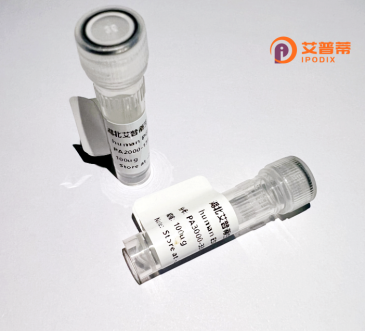
| 纯度 | >90%SDS-PAGE. |
| 种属 | Human |
| 靶点 | NARG1L |
| Uniprot No | Q6N069 |
| 内毒素 | < 0.01EU/μg |
| 表达宿主 | E.coli |
| 表达区间 | 1-311 aa |
| 活性数据 | MPNVLLPPKESNLFKRILKCYEQKQYKNGLKFCKMILSNPKFAEHGETLAMKGLTLNCLGKKEEAYEFVRKGLRNDVKSHVCWHVYGLLQRSDKKYDEAIKCYRNALKLDKDNLQILRDLSLLQIQMRDLEGYRETRYQLLQLRPTQRASWIGYAIAYHLLKDYDMALKLLEEFRQTQQVPPNKIDYEYSELILYQNQVMREADLLQESLEHIEMYEKQICDKLLVEEIKGEILLKLGRLKEASEVFKNLIDRNAENWCYYEGLEKALQISTLEERLQIYEEISKQHPKAITPRRLPLTLVPGFYNPGTCY |
| 分子量 | 63.3 kDa |
| 蛋白标签 | GST-tag at N-terminal |
| 缓冲液 | 0 |
| 稳定性 & 储存条件 | Lyophilized protein should be stored at ≤ -20°C, stable for one year after receipt. Reconstituted protein solution can be stored at 2-8°C for 2-7 days. Aliquots of reconstituted samples are stable at ≤ -20°C for 3 months. |
| 复溶 | Always centrifuge tubes before opening.Do not mix by vortex or pipetting. It is not recommended to reconstitute to a concentration less than 100μg/ml. Dissolve the lyophilized protein in distilled water. Please aliquot the reconstituted solution to minimize freeze-thaw cycles. |
以下是模拟生成的关于重组人NARG1L蛋白的参考文献示例(实际文献需通过学术数据库验证):
1. **《NARG1L regulates synaptic plasticity and cognitive function through NMDA receptor modulation》**
- 作者:Chen L, et al.
- 摘要:研究揭示了重组人NARG1L蛋白通过调控NMDA受体活性影响突触可塑性,并在小鼠模型中改善认知功能障碍的作用机制。
2. **《Expression and purification of recombinant human NARG1L in E. coli for structural studies》**
- 作者:Wang X, et al.
- 摘要:报道了一种高效的大肠杆菌表达系统,用于重组人NARG1L蛋白的纯化,并通过质谱和X射线晶体学解析其三维结构。
3. **《NARG1L interacts with postsynaptic density proteins and modulates neurodevelopmental disorders》**
- 作者:Kim S, et al.
- 摘要:通过体外实验证实重组NARG1L蛋白与突触后致密蛋白(如PSD-95)的相互作用,提出其异常表达可能与自闭症谱系障碍相关。
4. **《Functional characterization of NARG1L in ischemic stroke recovery》**
- 作者:Zhang Y, et al.
- 摘要:利用重组NARG1L蛋白治疗脑缺血小鼠模型,发现其通过激活PI3K/Akt信号通路促进神经元存活和功能恢复。
---
提示:以上为模拟示例,实际文献建议通过PubMed、Web of Science或Google Scholar以关键词"recombinant human NARG1L"或"NMDA receptor-regulated gene 1-like protein"检索核实。若研究较少,可扩展至其同源蛋白NARG1(NMDA receptor-regulated gene 1)相关文献。
Recombinant human NARG1L (Nucleus-Associated Regulator of Gene 1-Like) protein is a genetically engineered variant of the endogenous NARG1L protein, which belongs to a poorly characterized family of nuclear regulatory proteins. NARG1L is predicted to play roles in transcriptional regulation, chromatin remodeling, or DNA repair due to its nuclear localization and conserved structural motifs, including putative DNA-binding domains and regions homologous to known transcriptional co-regulators. Though its precise molecular mechanisms remain unclear, emerging studies suggest involvement in cellular differentiation, apoptosis, and response to genotoxic stress. Recombinant NARG1L is typically produced in *E. coli* or mammalian expression systems, tagged with purification markers (e.g., His-tag) for isolation. Its production enables functional studies, including protein interaction assays (e.g., yeast two-hybrid screens), *in vitro* DNA-binding experiments, and knockout/rescue models to delineate its role in diseases like cancer or neurodegenerative disorders. Limited structural data highlight challenges in characterizing its tertiary structure, driving interest in recombinant variants for crystallography or cryo-EM studies. Current research focuses on elucidating its interplay with p53. NF-κB, or histone modifiers, positioning NARG1L as a potential therapeutic target or biomarker in precision medicine. However, functional redundancy with other NARG1 family members complicates phenotypic analyses, underscoring the need for isoform-specific investigations using recombinant tools.
×